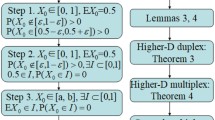Abstract
The paper studies the stabilization of the process of diffusion of binary opinions on networks. It first shows how such dynamics can be modeled and studied via techniques from binary aggregation, which directly relate to neighborhood frames. It then characterizes stabilization in terms of such neighborhood structures, and shows how the monotone \(\mu \)-calculus can express relevant properties of them. Finally, it illustrates the scope of these results by applying them to specific diffusion models.
Access this chapter
Tax calculation will be finalised at checkout
Purchases are for personal use only
Similar content being viewed by others
Notes
- 1.
Formally, an aggregator F is independent iff, for all \(p\in \mathbf{P}\): for any profiles \(\mathbf{O}, \mathbf{O}'\) such that for all \(i\in N, O_i(p) = O'_i(p)\), \(F(\mathbf{O})(p)=F(\mathbf{O}')(p)\). Independence is a natural assumption in settings like ours, where issues are assumed not to be logically interrelated.
- 2.
Recall that the ceiling function \(\lceil x \rceil \) denotes the smallest integer larger than x.
- 3.
More precisely, \(\mathbf{F}: N \rightarrow \left( \mathbf{P}\rightarrow \bigcup _{X \subseteq N} \left\{ \mathbf{0}, \mathbf{1} \right\} ^{\left\{ \mathbf{0},\mathbf{1} \right\} ^{|X|}} \right) \).
- 4.
It is worth noticing that \(\mathbf{F}(i)\) is not an aggregator in the strict sense, as the set of individuals whose opinions are aggregated varies from issue to issue. However, it can be represented by an aggregator on N where \(N \backslash R_p(i)\) are dummy agents, as shown later in Lemma 1. We will therefore slightly abuse terminology and still refer to such functions as aggregators.
- 5.
Note that the construction in the proof of Lemma 1 is such that each agent \(j \not \in R_p(i)\) participates to i’s set of winning and veto coalitions only as a ‘dummy’ agent who can be added or removed to a winning (or veto) coalition without changing the status of that coalition.
- 6.
Note that \(\{a,b\}\) and \(\emptyset \) are consensuses.
- 7.
The monotone \(\mu \)-calculus was already used in [3] to model threshold-based diffusion.
- 8.
These properties force the resulting class of structures to validate specific formulae expressed in the above language. We refer the reader to [21] for an overview of the logics induced by monotonic neighborhood structures and subclasses thereof.
- 9.
We alternatively write \(\mathcal {M}, i \models \varphi \) whenever \( i\in ||\varphi ||\).
- 10.
Note that this dynamics is the extreme case of linear averaging applied on binary opinions and binary influence.
- 11.
BDPs are also limit cases of propositional opinion diffusion processes recently proposed by [18], i.e., cases where (1) the aggregation rule is the unanimity rule (an agent changes its opinion if and only if all her influencers disagree with it), and (2) each agent has exactly one influencer. Note that, in general, the ‘unanimity rule’ from the setting of propositional opinion diffusion differs from what we call the unanimity rule, which prescribes not only to ‘change’ your opinion if all your influencers have the opposite opinion, but to adopt their opinion no matter what opinion you currently hold. In the limit case of BDPs, those two notions trivially coincide.
- 12.
These correspond to the typical case of ‘friendship’ networks (cf. [23]).
References
Azimipour, S., Naumov, P.: Lighthouse principle for diffusion in social networks. J. Appl. Logic. (2017, to appear)
Baltag, A., Christoff, Z., Rendsvig, R.K., Smets, S.: Dynamic epistemic logic of diffusion and prediction in social networks. In: Twelfth Conference on Logic and the Foundations of Game and Decision Theory (LOFT 2016) (2016)
Baltag, A., Sonja, S.: Logic goes viral - modalities for social networks. Presented at the workshop Trends in Logic - Presenting the Tsinghua-UvA Joint Research Center, Tsinghua University, 2 July 2014
van Benthem, J.: Oscillations, logic, and dynamical systems. In: Ghosh, S., Szymanik, J. (eds.) The Facts Matter. Essays on Logic and Cognition in Honour of Rineke Verbrugge, pp. 9–22. College Publications (2015)
van Benthem, J., Bezhanishvili, N., Enqvist, S., Junhua, Y.: Instantial neighbourhood logic. Rev. Symbol. Logic 10(1), 116144 (2017)
Botan, S.: Propositional opinion diffusion with constraints. ILLC Master of Logic Thesis (2016)
Chellas, B.F.: Modal Logic. An Introduction. Cambridge University Press, Cambridge (1980)
Cholvy, L.: Influence-based opinion diffusion (extended abstract). In: Proceedings of AAMAS 2016, pp. 1355–1356. IFAAMAS (2016)
Christoff, Z.: Dynamic logics of networks: information flow and the spread of opinion. Ph.D thesis, Institute for logic, Language and Computation, University of Amsterdam, Amsterdam, The Netherlands. ILLC Dissertation Series DS-2016-02 (2016)
Christoff, Z., Grossi, D.: Binary aggregation with delegable proxy: an analysis of liquid democracy. In: Proceedings of TARK 2017, EPTCS, vol. 251 (2017)
Degroot, M.H.: Reaching a consensus. J. Am. Stat. Assoc. 69(345), 118–121 (1974)
Dokow, E., Holzman, R.: Aggregation of binary evaluations. J. Econ. Theory 145(2), 495–511 (2010)
Endriss, U.: Judgment aggregation. In: Brandt, F., Conitzer, V., Endriss, U., Lang, J., Procaccia, A.D. (eds.) Handbook of Computational Social Choice, chap. 17. Cambridge University Press (2016)
Enqvist, S., Seifan, F., Venema, Y.: Expressiveness of the modal mu-calculus on monotone neighborhood structures. Technical report, arXiv: 1502.07889 (2015)
Friedkin, N.E., Proskurnikov, A.V., Tempo, R., Parsegov, S.E.: Network science on belief system dynamics under logic constraints. Science 354(6310), 321–326 (2016)
Goles, E.: Periodic behavior of generalized threshold functions. Discrete Math. 30, 187–189 (1980)
Grandi, U., Endriss, U.: Lifting integrity constraints in binary aggregation. Artif. Intell. 199, 45–66 (2013)
Grandi, U., Lorini, E., Perrussel, L.: Propositional opinion diffusion. In: Proceedings of the 2015 International Conference on Autonomous Agents and Multiagent Systems, AAMAS 2015, pp. 989–997. International Foundation for Autonomous Agents and Multiagent Systems, Richland (2015)
Granovetter, M.: Threshold models of collective behavior. Am. J. Sociol. 83(6), 1420–1443 (1978)
Grossi, D., Pigozzi, G.: Judgment aggregation: a primer. Synth. Lect. Artif. Intell. Mach. Learn. 8(2), 1–151 (2014)
Hansen, H.H.: Monotonic modal logics. Technical Report PP-2003-24, ILLC (2003)
Jackson, M.O.: Social and Economic Networks. Princeton University Press, Princeton (2008)
Liu, F., Seligman, J., Girard, P.: Logical dynamics of belief change in the community. Synthese 191(11), 2403–2431 (2014)
Acknowledgments
Zoé Christoff and Davide Grossi acknowledge support for this research by EPSRC (grant EP/M015815/1, “Foundations of Opinion Formation in Autonomous Systems”). Zoé Christoff also acknowledges support from the Deutsche Forschungsgemeinschaft (DFG) and Grantová agentura České republiky (GAČR) joint project RO 4548/6–1.
Author information
Authors and Affiliations
Corresponding author
Editor information
Editors and Affiliations
Rights and permissions
Copyright information
© 2017 Springer-Verlag GmbH Germany
About this paper
Cite this paper
Christoff, Z., Grossi, D. (2017). Stability in Binary Opinion Diffusion. In: Baltag, A., Seligman, J., Yamada, T. (eds) Logic, Rationality, and Interaction. LORI 2017. Lecture Notes in Computer Science(), vol 10455. Springer, Berlin, Heidelberg. https://doi.org/10.1007/978-3-662-55665-8_12
Download citation
DOI: https://doi.org/10.1007/978-3-662-55665-8_12
Published:
Publisher Name: Springer, Berlin, Heidelberg
Print ISBN: 978-3-662-55664-1
Online ISBN: 978-3-662-55665-8
eBook Packages: Computer ScienceComputer Science (R0)





